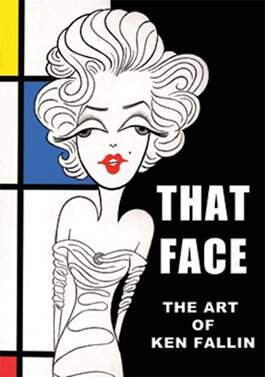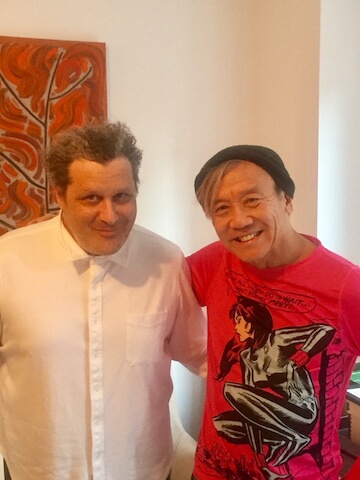THOMAS DUNNE BOOKS
She is perhaps not so well known today, but in her time and for a matter of decades Gloria Swanson (1899-1983) had a real claim to being the “greatest movie star of them all.” Of course, she was actually called that when she played Norma Desmond in “Sunset Boulevard,” the immortally defining summit of her career. Although she will be eternally identified as that maniacally leering, close-up-ready old broad slinking down a staircase, she had quite a full life both before and after this moment, and Stephen Michael Shearer’s new biography, “Gloria Swanson: the Ultimate Star” fully addresses this.
From her earliest screen days, as a plumpish silent bathing beauty in slapstick comedies, she had a spark, and, with her enormous aquamarine eyes, ski-slope nose, strong jaw, and blindingly big teeth, she riveted the camera. Later, in a series of “sophisticated” sex dramas directed by Cecil B. DeMille, she shot to stardom, gaining a reputation as the ultimate clotheshorse. Swathed in lame, jewels, leopard skin, and feathers and swanning about, she was every shop girl and housewife’s fantasy.
The greatest of stars, Fallin’s facial follies, “Risë forever
Swanson matured into a real actress in vehicles like “Manhandled” and “Sadie Thompson,” but talkies stymied her career. After making a sensational sound debut, even singing the popular hit “Love, Your Magic Spell is Everywhere,” in Edmund Goulding’s “The Trespasser” (1929), bad movie choices and a public’s changing tastes soon made this haughty movie queen passé.
She kept busy offscreen, however, waiting for her big “Sunset Boulevard” comeback in 1950 and then trying to surpass it, marrying six times and getting involved with radio, television, dress designing, four different patented inventions, and health food.
“There hadn’t been a book about since her autobiography and I felt it was time,” Shearer told me. “I began my research by going to the Harry Ransom Center at the University of Texas at Austin where they have 640 boxes of her archives, all meticulously catalogued over a nine-year period by her dear friend Raymond Daum. She saved everything –– receipts from Mack Sennett comedies, notes to her maid –– and I saw a lot of it, except for 11 boxes which are still awaiting a respectable amount of time before being opened. I tried to get hold of everyone who ever worked with her, especially television, as everyone from her silent movie days is now gone.
“When I read her book, I could hear her voice, one of most candid autobiographies ever. But I had to be very careful as she skipped over the last 30 years of her life to what she was then doing at present. Besides her life story, I’ve done a critical career study for which I had to learn about silent film acting technique.
Gloria Swanson biographer Stephen Michael Shearer.
“There were beautiful women before her –– Elsie Ferguson, Norma Talmadge –– but there never was a glamorous female movie star, which she created. Like Bette Davis, Joan Crawford, Diana Ross, she was an Aries, sharing their drive and assuredness. They’re ball-breakers, with a man’s mind, and she could be her own worst enemy. She had a great libido, which fascinated me, and she was refreshingly not stuck in Victorian morals. She may have written about how virtuous she was but she also included sleeping with the married Joseph Kennedy, who wanted a chance at the Hollywood gold ring as her producer but wouldn’t listen to anybody and totally ruined her financially.
“She loved to be adored by men, thinking she was the total vamp and when I talked to Arthur Whitelaw and Dirk Benedict, who were involved with her on the play “Butterflies are Free,” and also her last husband, William Dufty, and his lover, Dennis Fairchild, for the last 20 years of his life, they all said there were moments when she was in her 80s but could still be as enchanting as a little girl and sexually appealing.” Indeed, in a bizarre Dick Cavett appearance with Janis Joplin (who would be dead a few months later), Swanson wears a revealing gown showing off satiny smooth skin and looks younger than both of them.
“She had a very long, productive life and I hope I haven’t short-changed her, although it was a chore whittling my manuscript down,” Shearer said. “Unfortunately that left no room for a comprehensive filmography, which can be found on my website [smsmybooks.com]. By the end of the book, I wanted to show that this legendary icon was very human. I didn’t want to condemn her, but she was always a romantic. She became very vulnerable as she got older and a lot of her sensibility went out the window. She would never tell the truth, according to those who knew her well. Dufty helped her write her book, and that’s why you can hear her voice. He also did Billie Holiday’s autobiography and was a great mimic. But he had to do a lot of research and catch her off guard to get at the truth.
“Then she met this individual and fell so much in love that she wanted him to have proceeds from the book and he did nothing except possibly satisfy her, and that ruined her marriage with Dufty. I had to be very careful because this individual is still around and I couldn’t editorialize. He was either an angel or a demon, according to who I spoke to, but he was very charismatic, and Dirk said Gloria always was susceptible to anyone with an accent and charm. There are individuals who sensed that and took advantage and she lost her bank account, her farm in Portugal. She didn’t end up on the streets, for fortunately she saw the light at the end. But, had it been another time and lover, she could usually see through them a lot sooner. She always wanted romance and didn’t necessarily want the stereotypical husband and wife formula. I really don’t know if she wanted children. Fame, success, adoration, and accolades, yes, and always a father figure, a daddy to take care of her.”
Ken Fallin's exhibit runs through December 31.
With celebrity caricaturist Al Hirschfeld’s passing, a real era of show biz died, too, but one artist, Ken Fallin, is brightly holding the torch with his deliciously clever depictions of the famous and entitled, and his show at New World Stages (343 W. 49th St., daily, 10 a.m.-6 p.m., through Dec. 31; hangingart.org/fallin/) is sure to make you smile and maybe reach for your checkbook. The artist gave me a personal preview of the exhibit, which started with a drawing of Madonna and a chorus of other music stars as Rockettes, with kd lang as pit conductor.
“Madonna’s company was planning an HBO special, ‘Rock Goes Broadway,’ so I had to draw Jagger, McCartney, Whitney Houston, and she had approval,” Fallin explained. “She approved everyone but herself and I had to keep changing the drawing, making her prettier and prettier until she looked like Grace Kelly, and that’s what she approved. The project never happened, but I got paid.”
From Gainesville, Florida, Fallin came to New York at 17 to be an actor but soon realized, in summer stock, that he made more money drawing and doing posters.
“I never thought this could be a profession but had always drawn as a kid and loved those old Warner Brothers cartoons of the stars,” he said. “Hirschfeld was indeed a big influence when I first saw his work. I didn’t know who the people were but I loved his drawing and when I got my first success with ‘Forbidden Broadway,’ I copied him on purpose. That started getting me work as an illustrator on Broadway and I tried to get as far away as I could, but there is always going to be a little Hirschfeld in there, which is fine. I was told that he once came to ‘Forbidden,’ saw my work, and thought he had done it himself, which was very flattering. His wife Louise has been very encouraging and supportive.”
Screw computers, Fallin works old school, like a real artist: “Pen and ink, and I use that old-fashioned quill pen you have to keep dipping. I start with a pencil drawing first and then ink it in, and if you look closely you can see my erase marks and such.”
Asked whom he could draw in his sleep, he replied, “Carol Channing, Streisand. Liza. I went nuts years ago and bought a Hirschfeld of her from a TV show, ‘The Dangerous Christmas of Little Red Riding Hood.’ We were living in Boston and met her at a party and when I mentioned I had this, she said she had never seen it, so why don’t I come to her concert as her guest and bring it? It was huge but I schlepped it along with a drawing I did of her for the Boston Herald. After a great concert, we went to her dressing room and she was very excited. I pulled out my drawing, and her face fell. So I thought, ‘Quick, show her the Hirschfeld.’ When she saw that, she buried her head in her boyfriend’s shoulder and said, ‘Now I know why they never show these to me.’ I felt so awful, and later found out she hates caricatures and can’t stand to see people do impressions of her. Very sensitive. So a very good lesson. Two years ago she did a show with Sam Harris at Birdland, and I did a very flattering drawing and took it with me. She was very happy, and I took a picture with her and Sam.
“But you never know, people don’t see themselves as other people see them. I did one of Patrick Stewart for ‘A Life in the Theater,’ and his manager called and said he was interested in buying it. We saw the play and went back after and he was like an old friend, so warm and friendly, laughing, ‘I love caricatures of myself!’ He collects them.
“I do cruise ships, too, and on one I met a man who asked if I ever did Renée Zellweger? I said, ‘I don’t think so.’ ‘Well, I’m her father.’ He and his wife came to my drawing class and I did one of them they liked so well that they used it for their stationary for their 50th wedding anniversary party in Montreal. They invited me and my partner [and husband, Stanley Steinberg, of 45 years], and Renée was there. She joked, ‘Don’t caricature me!’ but seemed to have a sense of humor. It was just us and about 20 people –– we couldn’t figure it out –– but that’s what’s special. My drawings have taken me so many places!”
“Risë: a Celebration of Risë Stevens” was a special event hosted by the Metropolitan Opera Guild at the Kaye Playhouse on September 18 honoring the great America mezzo-soprano who died earlier this year. That album with her glamorous Carmen on the cover was the first opera record I ever bought, and it was her, along with seeing Pavarotti live, that really brought me to opera. Getting over my first big break-up, I would fall asleep to her “Che farò senza Euridice” every night, and the sound of her lustrous, warm voice was far more therapeutic than any shrink could dream of being.
A beautifully produced evening, hosted by the wonderful Frederica von Stade, the tribute featured rare performance clips of Stevens doing everything from the famous Tyrone Guthrie “Carmen” to soft-shoeing with Ray Bolger and singing 1950s commercials.
At the posh afterparty at the Lotos Club, I spoke to charming arts patroness Ann Ziff, who made me realize the incredible debt the Met owes Stevens. Ziff’s mother was the opera singer Harriet Henders, who had worked closely with Stevens in Europe. Ziff recalled for the evening’s guests having shyly approached the formidably glamorous diva and her imposing husband Walter Surovy at a function and initially being met with polite disdain. When she mentioned her mother, however, the ice melted and Ziff found herself with a new best friend and surrogate Mom.
Stevens took Ziff under her opera wing, and the Met now enjoys some truly substantial support from her. When I mentioned to her that, like her good friend Renée Fleming, Stevens popularized the art form and performed in different mediums, Ziff smiled but demurred, “Oh, but Risë really did it! You saw her tonight, showing all her different talents, so versatile, and she so put her own stamp on everything she did. With her, it was all about having fun and getting the most enjoyment out of every night! Walter was such a total rogue, too!”
I asked Ziff about her mother, and she said, “She gave up singing when she married. But she was known for her ‘Rusalka’ ‘Song to the Moon.’ And Strauss, and Mozart. In fact, a very similar repertoire to Renee’s!”
The really down-to-earth Ziff is quite the glam clotheshorse herself, and she said, “I can’t believe you remember that feathered thing I wore to Renée’s ‘Rusalka”! This jacket? It’s a 15-year-old Scaasi!”
Contact Noh at Inthenoh@aol.com, follow him on Twitter @in_the_noh, and check out his blog at http://nohway.wordpress.com/.






































